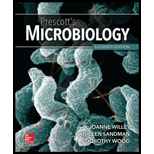
Prescott's Microbiology
11th Edition
ISBN: 9781260409062
Author: WILLEY, Joanne
Publisher: MCGRAW-HILL HIGHER EDUCATION
expand_more
expand_more
format_list_bulleted
Concept explainers
Question
Chapter 39.1, Problem 3CC
Summary Introduction
Corynebacterium diphtheriae is the causative agent of diphtheria, a contagious disease. Corynebacterium diphtheriae is well adapted to airborne transmissions through nasopharyngeal secretions. Mostly, diphtheria affects unimmunized people. The common symptoms of diphtheria include fever, sore throat, and barky cough. Some strains of Corynebacterium diphtheriae produce a toxin, which causes serious complications of diphtheria.
Expert Solution & Answer
Want to see the full answer?
Check out a sample textbook solution
Students have asked these similar questions
Which of the following is not a sequence-specific DNA binding protein?
1. the catabolite-activated protein
2. the trp repressor protein
3. the flowering locus C protein
4. the flowering locus D protein
5. GAL4
6. all of the above are sequence-specific DNA binding proteins
Which of the following is not a DNA binding protein?
1. the lac repressor protein
2. the catabolite activated protein
3. the trp repressor protein
4. the flowering locus C protein
5. the flowering locus D protein
6. GAL4
7. all of the above are DNA binding proteins
What symbolic and cultural behaviors are evident in the archaeological record and associated with Neandertals and anatomically modern humans in Europe beginning around 35,000 yBP (during the Upper Paleolithic)?
Chapter 39 Solutions
Prescott's Microbiology
Ch. 39.1 - What organisms serve as the environmental...Ch. 39.1 - How is the M protein also thought to be involved...Ch. 39.1 - Prob. 3MICh. 39.1 - Why do you think chlamydiae differentiate into...Ch. 39.1 - Compare and contrast the means by which people...Ch. 39.1 - Prob. 3CCCh. 39.1 - What are the three major causes of meningitis? Why...Ch. 39.1 - Prob. 5CCCh. 39.1 - How do multidrug-resistant strains of tuberculosis...Ch. 39.1 - Prob. 7CC
Ch. 39.1 - What is the mechanism by which PTx kills host...Ch. 39.1 - Prob. 9CCCh. 39.1 - Prob. 10CCCh. 39.2 - What are the three stages of Lyme disease? What...Ch. 39.2 - Prob. 1CCCh. 39.2 - Prob. 2CCCh. 39.2 - Prob. 3CCCh. 39.2 - Prob. 4CCCh. 39.3 - What are the chief differences between tuberculoid...Ch. 39.3 - How does H. pylori increase the local pH in its...Ch. 39.3 - Prob. 3MICh. 39.3 - Prob. 4MICh. 39.3 - Prob. 5MICh. 39.3 - Prob. 1CCCh. 39.3 - Why do you think the slow growth rate of M. leprae...Ch. 39.3 - Prob. 3CCCh. 39.3 - Prob. 4CCCh. 39.3 - Prob. 5CCCh. 39.3 - Prob. 6CCCh. 39.3 - Prob. 7CCCh. 39.3 - What is the difference between S. aureus and MRSA?Ch. 39.3 - Prob. 9CCCh. 39.3 - Prob. 10CCCh. 39.3 - Prob. 11CCCh. 39.4 - How do the neurological effects of botulinum toxin...Ch. 39.4 - To which E. coli class does the strain 0157:H7...Ch. 39.4 - Prob. 1CCCh. 39.4 - Compare the gastroenteritis caused by Vibrio...Ch. 39.4 - Prob. 3CCCh. 39.4 - Prob. 4CCCh. 39.4 - Prob. 5CCCh. 39.4 - Prob. 6CCCh. 39.4 - Prob. 7CCCh. 39.5 - Prob. 1MICh. 39.5 - Prob. 1CCCh. 39.5 - Prob. 2CCCh. 39.5 - How is ornithosis transmitted?Ch. 39.5 - Prob. 4CCCh. 39.6 - What cells and tissues make up the pseudomembrane?Ch. 39.6 - Prob. 2MICh. 39.6 - In both C. difficileassociated disease and...Ch. 39.6 - Prob. 2CCCh. 39.6 - Prob. 3CCCh. 39.6 - Prob. 4CCCh. 39 - Prob. 1RCCh. 39 - Prob. 2RCCh. 39 - Prob. 3RCCh. 39 - Prob. 4RCCh. 39 - Prob. 5RCCh. 39 - Prob. 1ALCh. 39 - Prob. 2ALCh. 39 - Prob. 3ALCh. 39 - Prob. 4ALCh. 39 - Prob. 5ALCh. 39 - Prob. 6AL
Knowledge Booster
Learn more about
Need a deep-dive on the concept behind this application? Look no further. Learn more about this topic, biology and related others by exploring similar questions and additional content below.Similar questions
- Describe three cranial and postcranial features of Neanderthals skeletons that are likely adaptation to the cold climates of Upper Pleistocene Europe and explain how they are adaptations to a cold climate.arrow_forwardBiology Questionarrow_forward✓ Details Draw a protein that is embedded in a membrane (a transmembrane protein), label the lipid bilayer and the protein. Identify the areas of the lipid bilayer that are hydrophobic and hydrophilic. Draw a membrane with two transporters: a proton pump transporter that uses ATP to generate a proton gradient, and a second transporter that moves glucose by secondary active transport (cartoon-like is ok). It will be important to show protons moving in the correct direction, and that the transporter that is powered by secondary active transport is logically related to the proton pump.arrow_forward
- drawing chemical structure of ATP. please draw in and label whats asked. Thank you.arrow_forwardOutline the negative feedback loop that allows us to maintain a healthy water concentration in our blood. You may use diagram if you wisharrow_forwardGive examples of fat soluble and non-fat soluble hormonesarrow_forward
- Just click view full document and register so you can see the whole document. how do i access this. following from the previous question; https://www.bartleby.com/questions-and-answers/hi-hi-with-this-unit-assessment-psy4406-tp4-report-assessment-material-case-stydu-ms-alecia-moore.-o/5e09906a-5101-4297-a8f7-49449b0bb5a7. on Google this image comes up and i have signed/ payed for the service and unable to access the full document. are you able to copy and past to this response. please see the screenshot from google page. unfortunality its not allowing me attch the image can you please show me the mathmetic calculation/ workout for the reult sectionarrow_forwardIn tabular form, differentiate between reversible and irreversible cell injury.arrow_forwardhelparrow_forward
- Can you please help me answer these questions?arrow_forwardSkryf n kortkuns van die Egyptians pyramids vertel ñ story. Maximum 500 woordearrow_forward1.)What cross will result in half homozygous dominant offspring and half heterozygous offspring? 2.) What cross will result in all heterozygous offspring?arrow_forward
arrow_back_ios
SEE MORE QUESTIONS
arrow_forward_ios
Recommended textbooks for you
- Case Studies In Health Information ManagementBiologyISBN:9781337676908Author:SCHNERINGPublisher:CengageSurgical Tech For Surgical Tech Pos CareHealth & NutritionISBN:9781337648868Author:AssociationPublisher:Cengage


Case Studies In Health Information Management
Biology
ISBN:9781337676908
Author:SCHNERING
Publisher:Cengage

Surgical Tech For Surgical Tech Pos Care
Health & Nutrition
ISBN:9781337648868
Author:Association
Publisher:Cengage



12DaysinMarch, Genital Infections for USMLE Step One; Author: Howard Sachs;https://www.youtube.com/watch?v=66zR_FypVFQ;License: Standard youtube license